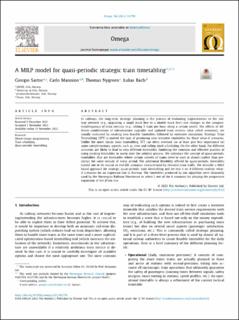| dc.contributor.author | Sartor, Giorgio | |
| dc.contributor.author | Mannino, Carlo | |
| dc.contributor.author | Nygreen, Thomas | |
| dc.contributor.author | Bach, Lukas | |
| dc.date.accessioned | 2023-02-23T12:55:27Z | |
| dc.date.available | 2023-02-23T12:55:27Z | |
| dc.date.created | 2022-12-06T13:36:34Z | |
| dc.date.issued | 2022 | |
| dc.identifier.citation | Omega. The International Journal of Management Science. 2022, 116, 102798. | en_US |
| dc.identifier.issn | 0305-0483 | |
| dc.identifier.uri | https://hdl.handle.net/11250/3053622 | |
| dc.description.abstract | In railways, the long-term strategic planning is the process of evaluating improvements to the railway network (e.g., upgrading a single track line to a double track line) and changes to the composition/frequency of train services (e.g., adding 1 train per hour along a certain route). The effects of different combinations of infrastructure upgrades and updated train services (also called scenarios), are usually evaluated by creating new feasible timetables followed by extensive simulation. Strategic Train Timetabling (STT) is indeed the task of producing new tentative timetables for these what-if scenarios. Unlike the more classic train timetabling, STT can often overlook (or at least give less importance to) some complementary aspects, such as crew and rolling stock scheduling. On the other hand, the different scenarios are likely to lead to very different timetables, hindering the common and effective practice of using existing timetables to warm start the solution process. We introduce the concept of quasi-periodic timetables, that are timetables where certain subsets of trains need to start at almost (rather than precisely) the same minute of every period. The additional flexibility offered by quasi-periodic timetables turned out to be crucial in real-life scenarios characterized by elevated train traffic. We describe a MILP based approach for strategic quasi-periodic train timetabling and we test it on 4 different realistic what-if scenarios for an important line in Norway. The timetables produced by our algorithm were ultimately used by the Norwegian Railway Directorate to select 3 out of the 4 scenarios for phasing the progressive expansion of the JȪren line. | en_US |
| dc.language.iso | eng | en_US |
| dc.publisher | Elsevier | en_US |
| dc.rights | Navngivelse 4.0 Internasjonal | * |
| dc.rights.uri | http://creativecommons.org/licenses/by/4.0/deed.no | * |
| dc.title | A MILP model for quasi-periodic strategic train timetabling | en_US |
| dc.title.alternative | A MILP model for quasi-periodic strategic train timetabling | en_US |
| dc.type | Peer reviewed | en_US |
| dc.type | Journal article | en_US |
| dc.description.version | publishedVersion | en_US |
| dc.rights.holder | © 2022 The Author(s) | en_US |
| dc.source.pagenumber | 18 | en_US |
| dc.source.volume | 116 | en_US |
| dc.source.journal | Omega. The International Journal of Management Science | en_US |
| dc.identifier.doi | 10.1016/j.omega.2022.102798 | |
| dc.identifier.cristin | 2089431 | |
| dc.relation.project | Norges forskningsråd: 300509 | en_US |
| dc.source.articlenumber | 102798 | en_US |
| cristin.ispublished | true | |
| cristin.fulltext | original | |
| cristin.qualitycode | 2 | |

